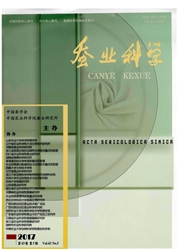

 中文摘要:
中文摘要:
研究家蚕微孢子虫(Nosema bombycis,Nb)的孢壁蛋白对于揭示家蚕微孢子虫感染宿主的分子机制具有重要意义。对已完成精细定位的家蚕微孢子虫孢壁蛋白SWP25、SWP30、SWP32在家蚕中肠组织中的表达谱进行了分析。RT-PCR结果表明,SWP32在感染后24 h就可以检测到其转录本,SWP25、SWP30的转录本在感染后36 h可检测到,提示SWP32可能在孢子裂殖体阶段就需要发挥作用;3种孢壁蛋白在感染3 d后其转录本均达到较高水平,并在感染过程中持续保持,在感染后第10天仍能明显检出。3种孢壁蛋白在感染3 d后转录本量明显增加的现象与家蚕微孢子虫的生活史相符合,即:孢子母细胞在此阶段迅速增加并向成熟孢子转化,成熟孢子的孢壁在这一时期形成。3种孢壁蛋白的表达能在感染早期阶段的家蚕中肠组织中被检出,为进一步探讨3种蛋白的功能提供了线索,也为开发基于这3种蛋白的分子生物学及免疫学特异性的家蚕微粒子病早期诊断技术提供了理论依据。
 英文摘要:
英文摘要:
Researching on spore wall proteins of Nosema bombycis contributes useful information to discover the molecular mechanism of pathogen invasion. Here we present the expression patterns of three major spore wall proteins (SWP25, SWP30 and SWP32) in the infected midgut of silkworm. RT-PCR results indicate that the transcripts of SWP32 can be amplified at 24 hour post infection (hpi), and transcripts of SWP25 and SWP30 can be detected at 36 hpi, which suggest that SWP32 plays its role in early stage ( meront stage). And for all three SWPs, an obvious expression occurred at 72 hpi and lasted in the whole observed period (3- 10 days post inoculation), which is consistent with the life cycles of N. bombycis that 72 hpi is the transforming stage between sporoblast and mature spore. In this period, the spore wall is forming and becoming thicker. Our study provides a new clue for further functional characterization of these three SWPs. Meanwhile, their expression profiles provide useful information for developing early diagnostic methods to infection caused by N. bombycis.
 同期刊论文项目
同期刊论文项目
 同项目期刊论文
同项目期刊论文
 期刊信息
期刊信息
